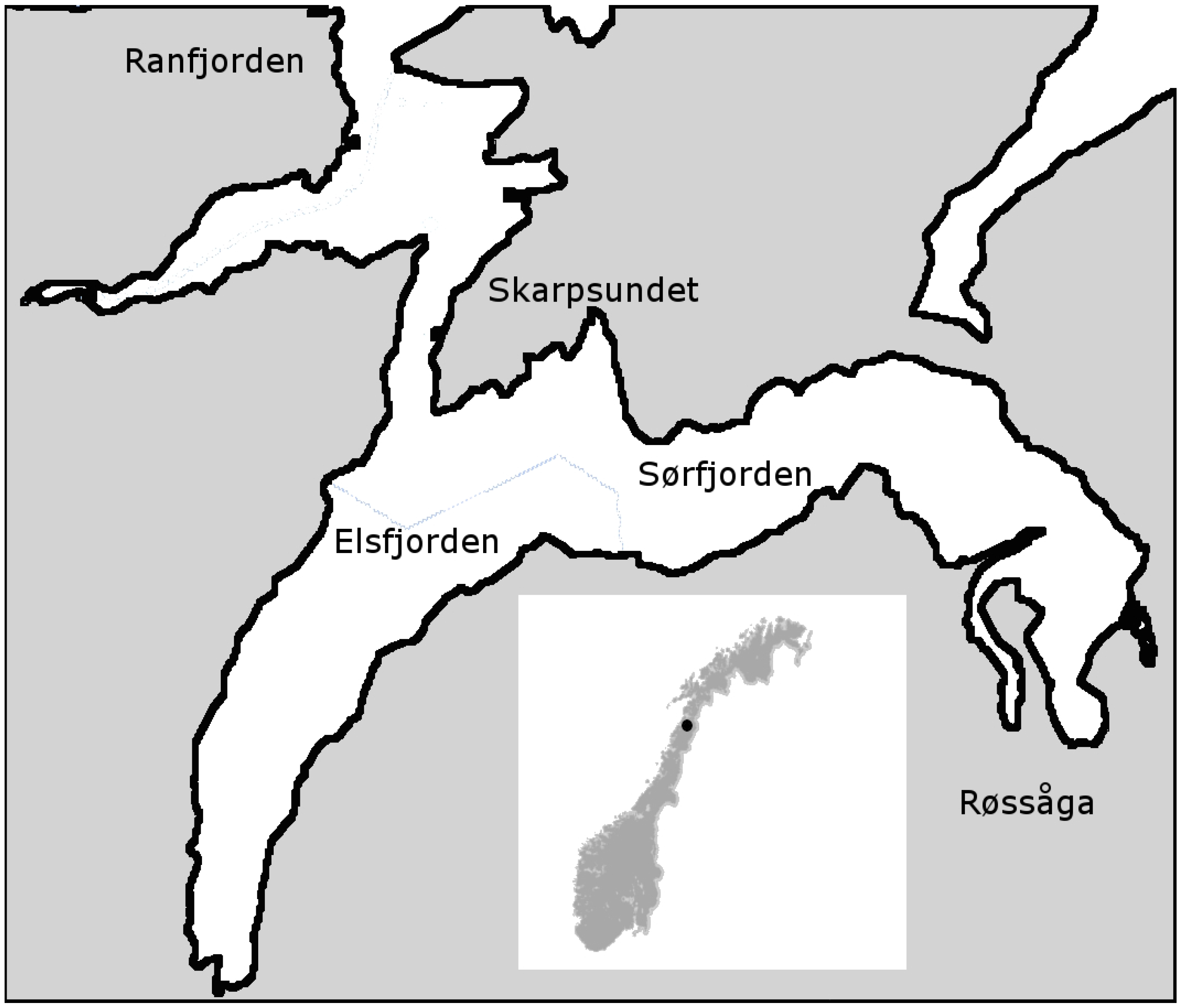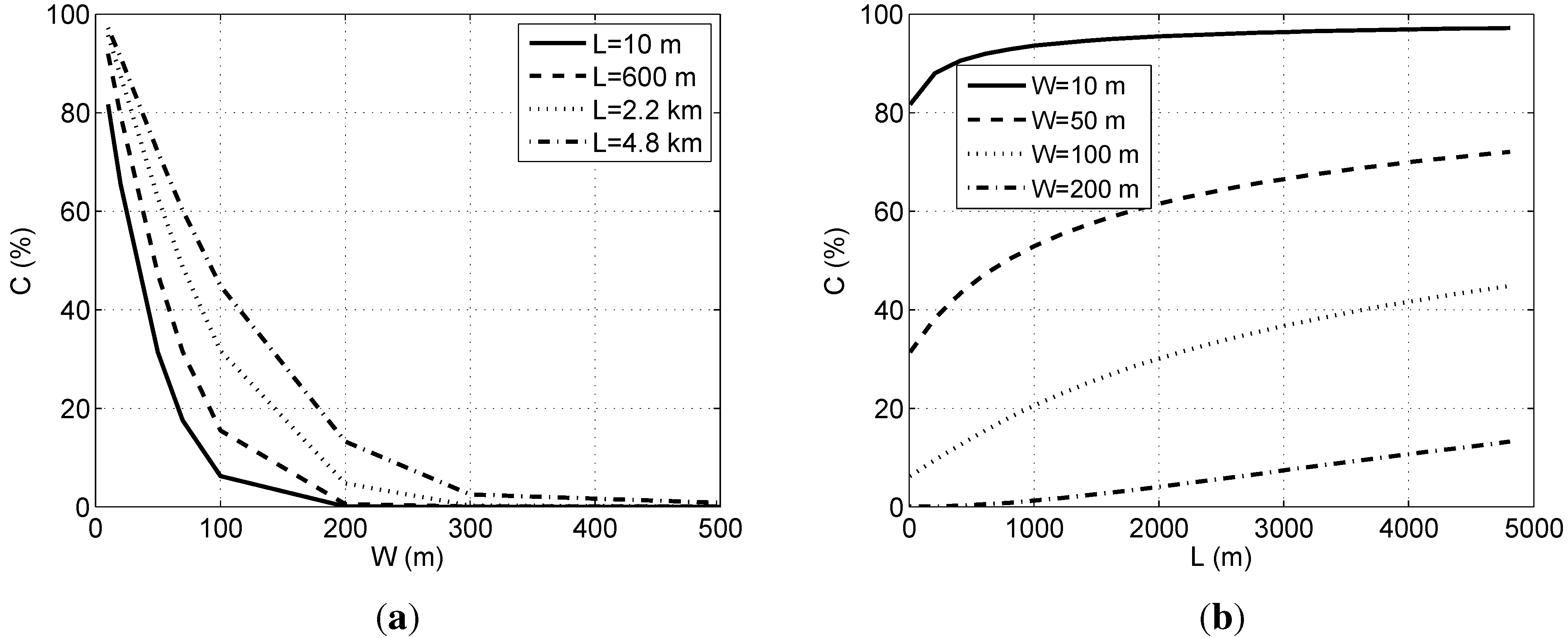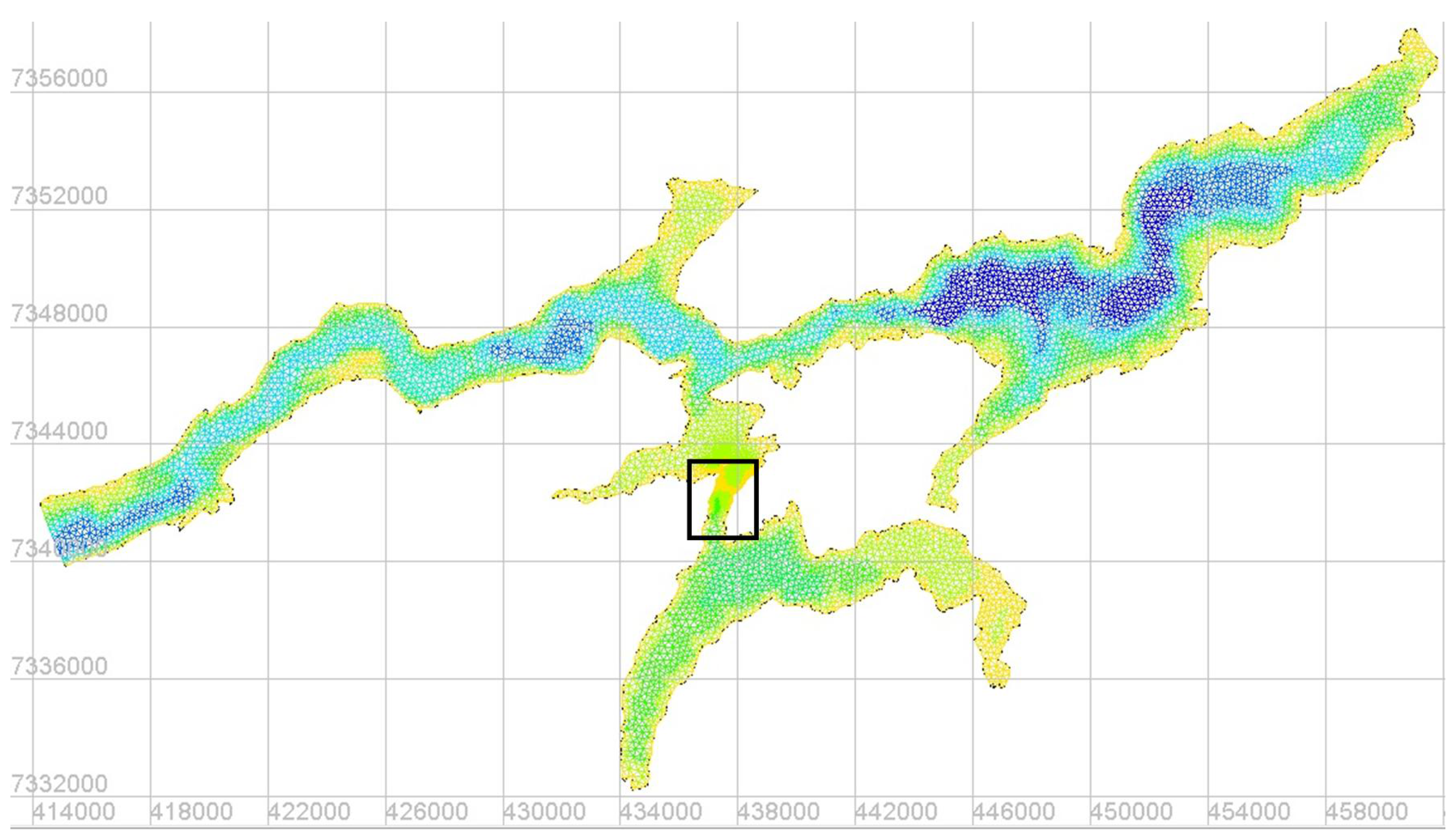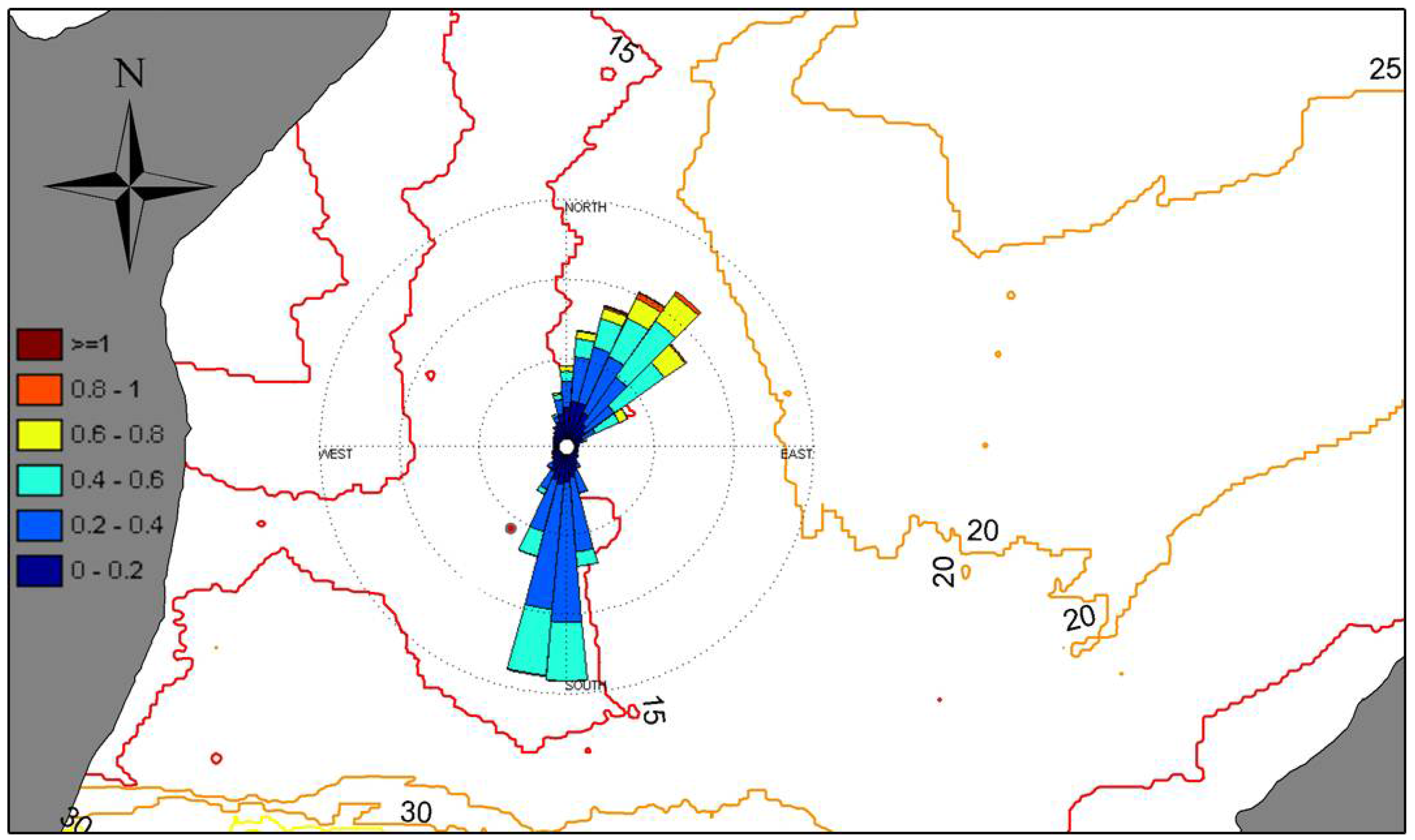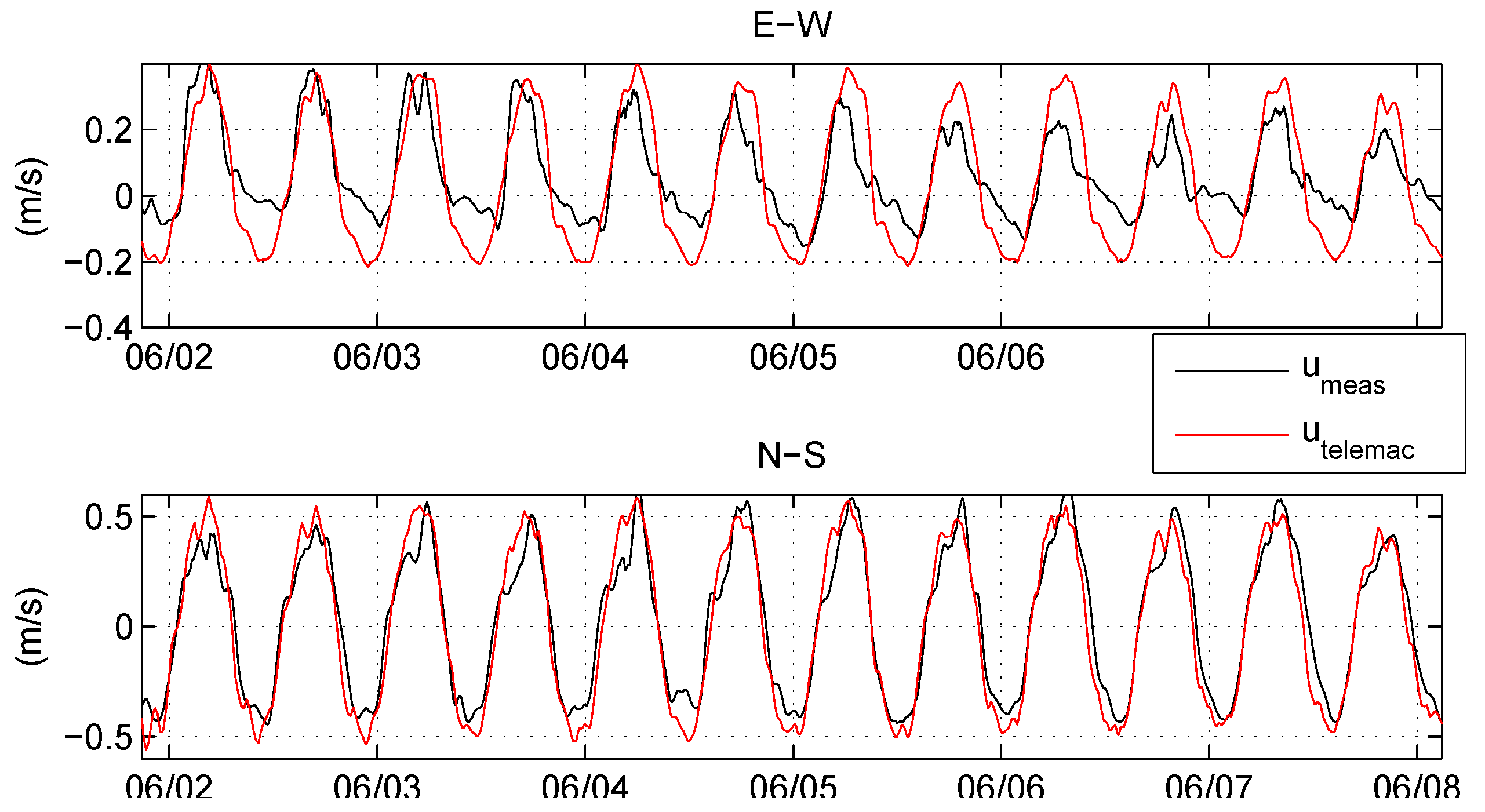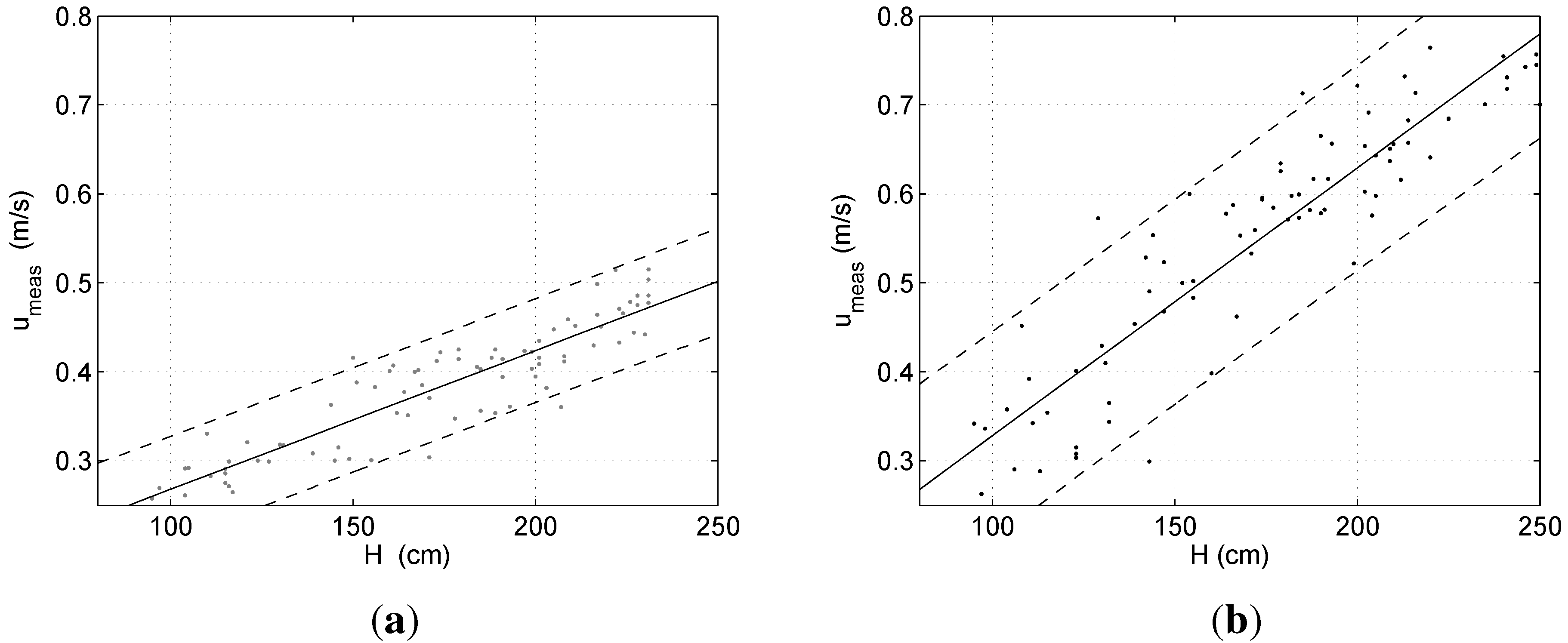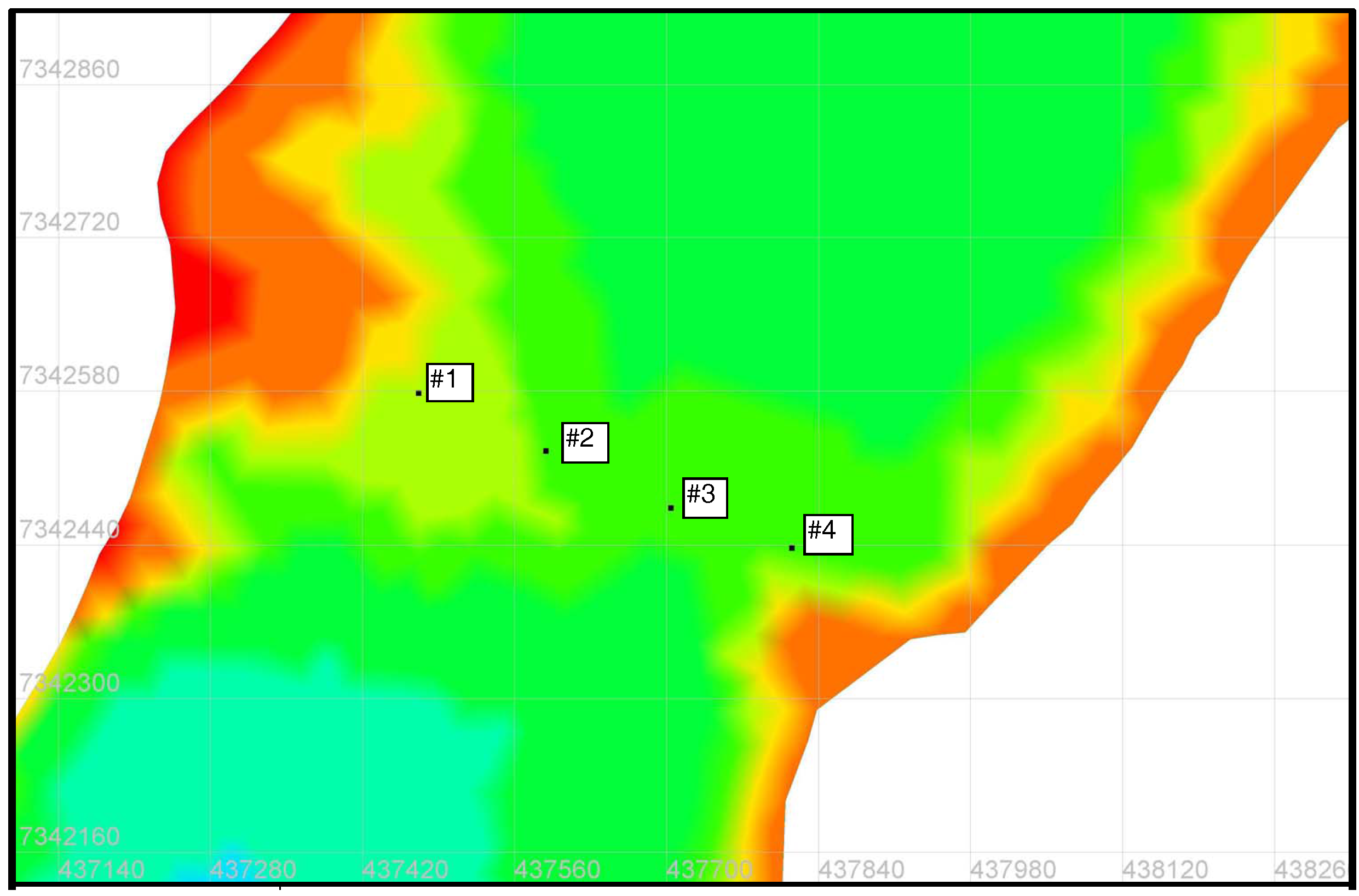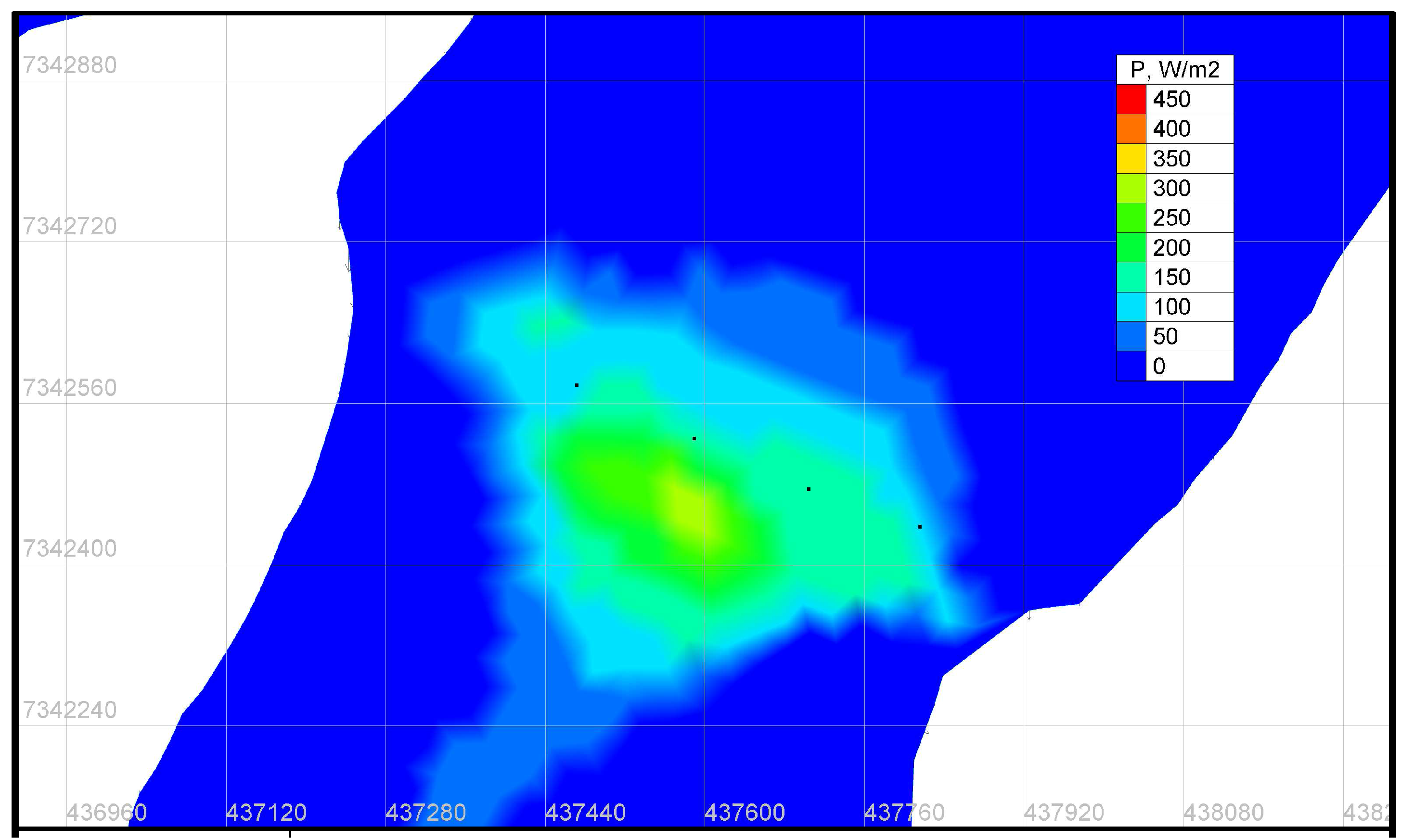4.1. Velocity and Tidal Level Data Results
The description of the data at different depth is presented in
Table 4. The sustained maximum velocity [
12] is here defined as the maximum velocity sustained for 20 min during the whole time series. Since measurements were collected every 10 min, this means a maximum of the average of two data points. Due to disturbances close to the surface, the top bins were removed, keeping only the bins measuring from 3 up to 11 m above the bottom.
Table 4.
Statistics of the total, the flood and the ebb velocity for a few of the depths bins.
z = height above bottom,
= mean velocity,
is the sustained maximum velocity [
12] and
θ is the average direction.
Table 4.
Statistics of the total, the flood and the ebb velocity for a few of the depths bins. z = height above bottom, = mean velocity, is the sustained maximum velocity [12] and θ is the average direction.
| Flow | z | | | θ |
|---|
| | (m) | (m/s) | (m/s) | (degree) |
|---|
| | 3 | 0.25 | 1.24 | 191 |
| Total | 6 | 0.32 | 1.13 | 199 |
| | 9 | 0.33 | 1.00 | 192 |
| | all | 0.31 | 1.10 | 194 |
| | 3 | 0.22 | 0.48 | 176 |
| Flood | 6 | 0.27 | 0.59 | 188 |
| (incoming tide) | 9 | 0.29 | 0.58 | 183 |
| | all | 0.27 | 0.60 | 184 |
| | 3 | 0.28 | 1.24 | 25 |
| Ebb | 6 | 0.37 | 1.13 | 31 |
| (outgoing tide) | 9 | 0.35 | 1.00 | 20 |
| | all | 0.34 | 1.09 | 23 |
The directions can be seen in
Figure 5. The main direction for the flow going out of the fjord is on average N–NE. The spreading of the direction was mostly a result of differences in the vertical layers. For the flow going into the fjord the main direction was S–SW.
The magnitude of the sustained maximum velocity was almost double for the outgoing tide. The reason for this large difference is probably changed flow paths between in- and outgoing tide, discussed further in
Section 4.2. This might not have been observed had the ADCP been placed in the middle of the channel. A Butterworth low-pass filter with a 30 h cut-off frequency was applied on the time-series to remove the influence of the tidal components. The residual current, shown in
Figure 6, is caused either by freshwater outflow from the fjord or a differed flow path between ebb and flood in the channel. As seen in the figure, the velocity in the bottom layer and mid-depth layer decreases during neap tide, and increases during spring. The dominant tidal components (semi-diurnal and diurnal) have been removed from the time-series, but a neap-spring relationship is visible. The residual velocity is thus related to the tidal variations, and is not only a cause of the freshwater outflow from the fjord. The change in flow path can thus be a cause of this.
Figure 5.
Direction and velocity for the ADCP measurement series. Lengths of bars show incidence of each direction segment and the color bar shows the velocity in m/s.
Figure 5.
Direction and velocity for the ADCP measurement series. Lengths of bars show incidence of each direction segment and the color bar shows the velocity in m/s.
Figure 6.
Butterworth low-pass filter applied on the time-series of the velocity. Shown is the residual current for the depth 3, 6 and 9 m above the bottom.
Figure 6.
Butterworth low-pass filter applied on the time-series of the velocity. Shown is the residual current for the depth 3, 6 and 9 m above the bottom.
The observed higher sustained maximum velocity for the bottom layer compared with layers above is a result of a few occasions (approximately 6 of 84 peaks) where this occurred. In general, the mean velocity for the bottom layer is lower than the depth mean. The frequency of each velocity segment was not taken into account in the calculation of the sustained maximum. However, what causes this increase in velocity for the bottom layer from time to time is unknown.
The tidal level data received from the NHS (observed and predicted) was compared with tidal data measured with the ADCP using its built-in pressure sensor. The results are presented in
Table 5 and
Figure 7.
It can be seen that the tidal level data received from the NHS has some discrepancy from the level measured by the ADCP. The NHS values underestimate the measured tidal range by approximately 14 cm. These differences correspond to 7% of the total tidal range. The average of the time lag was 2–3 min, meaning that even though the maximum tidal level occurred at different times between the
Table 5.
Difference in tidal range [amplitude difference (amp. diff.)] and time lag between tidal data received from the NHS (observed and predicted) to measured data from the ADCP (measurement #1) in Skarpsundet.
Table 5.
Difference in tidal range [amplitude difference (amp. diff.)] and time lag between tidal data received from the NHS (observed and predicted) to measured data from the ADCP (measurement #1) in Skarpsundet.
| Difference | Predicted (NHS) | Observed (NHS) |
|---|
| | Amp. diff. | Time lag | Amp. diff. | Time lag |
|---|
| Mean | 14 cm | 2 min | 13 cm | 3 min |
| Max | 28 cm | 20 min | 26 cm | 40 min |
| Min | 0 cm | −20 min | 1 cm | −20 min |
Figure 7.
Comparison of the calculated tidal range between received data from the NHS and measured ADCP tidal level data. = 99%. Black dots show the flood tidal range, and red dots the ebb tidal range.
Figure 7.
Comparison of the calculated tidal range between received data from the NHS and measured ADCP tidal level data. = 99%. Black dots show the flood tidal range, and red dots the ebb tidal range.
NHS and the ADCP, the total effect was on average close to zero. It should be noted that since the data from the NHS is measured every 10 min, a time lag difference of 2–3 min is a result of averages, and not an actual observation.
The correlation is good (
-value of 99%) between the ADCP-measured and the NHS-predicted tidal value, which is a requirement for further analysis using tidal level data. As seen in
Figure 7, the ebb tidal range has less variation than the flood tidal range.
4.2. Cross-Sectional Velocity
The cross-sectional measurement was only carried out during a rising tide and thus only the velocity field for the incoming tide has been analysed. The tidal level above sea-chart zero was approximately 150 cm during the measurements and the tidal range approximately 200 cm. Since the measurements were carried out 0.5–1.5 h after the estimated time for the highest velocity, the velocities have been scaled assuming a sinusoidal variation to find estimates of the maximum velocity. The cross-sectional average velocity for the two transects was calculated and fitted into a sine curve, yielding a maximum velocity and a time lag for the occurring tide. This correction, adding 1% and 9% to transect measurement 1 and 2 respectively, have been applied in the below calculations.
The result from the two cross-section measurement is shown in
Figure 8. The arrows show the depth mean velocity. The average cross-sound velocity was calculated using WinRiver and then scaled, giving a cross-sectional average of 0.4 m/s. In the area of high velocity, from the east bank to the middle of the channel, the scaled depth-averaged velocity was 0.7 m/s.
Figure 8.
Results from the cross-sectional measurement. The tide was rising and measurements occurred at 4–5 h after low tide. (a) shows the depth average velocities; and (b) the velocities through the cross-section. Depth is shown in (b) as a thick black line. Cross-sectional average velocity is 0.4 m/s and in 300–700 m in (b) the depth average velocity is 0.7 m/s.
Figure 8.
Results from the cross-sectional measurement. The tide was rising and measurements occurred at 4–5 h after low tide. (a) shows the depth average velocities; and (b) the velocities through the cross-section. Depth is shown in (b) as a thick black line. Cross-sectional average velocity is 0.4 m/s and in 300–700 m in (b) the depth average velocity is 0.7 m/s.
From
Figure 8, it can be seen that most of the flow during incoming tide is moving at the eastern part of the sound. These results are compared with the TELEMAC simulation and discussed in
Section 4.3.
4.3. Simulation Results
The velocity measured with the ADCP (measurement #1) was compared with the simulated velocities from the TELEMAC-2D simulation output (
Figure 9). The N-S velocity component agrees well with the simulated values (
Figure 9). The simulated E-W velocity component does not agree well with the measured one, especially not for the incoming tide (negative values). However, for the incoming tide the N-S velocity component is dominant and thus much larger. The measurement results showed this in
Figure 5.
The simulated velocity across the channel is shown in
Figure 10. In order for the figures to be comparable with the velocity from the cross-sectional measurement, the plots were taken from a time when the tidal range for the incoming tide was 200 cm. The figure for the outgoing tide (
Figure 10b) shows the velocity for the subsequent tide, in which the tidal range was 190 cm. The location of the long-time ADCP measurement is shown with a square as a reference.
Figure 9.
Comparison of the E-W and the N-S velocity components between simulated velocity and measured velocity. The simulation was performed with a surface level representing the tide from 1 June to 9 June 2011.
Figure 9.
Comparison of the E-W and the N-S velocity components between simulated velocity and measured velocity. The simulation was performed with a surface level representing the tide from 1 June to 9 June 2011.
Figure 10.
Velocity field in the sound Skarpsundet modelled with TELEMAC. The tidal range was at the time of the simulation 200 cm (left) and 190 cm (right). Velocity in (a) incoming tide; and (b) outgoing tide is marked with arrows, and the colours represent the bathymetry. The ADCP measurements are marked out where the dot represents the long-time measurement and the line the cross-sectional measurement; (c) Incoming tide profile; and (d) outgoing tide profile show velocity extracted at the same location as the cross-sectional measurement (thin lines) and depth (thick lines). The cross-sectional measurement is plotted in (c) for a comparison.
Figure 10.
Velocity field in the sound Skarpsundet modelled with TELEMAC. The tidal range was at the time of the simulation 200 cm (left) and 190 cm (right). Velocity in (a) incoming tide; and (b) outgoing tide is marked with arrows, and the colours represent the bathymetry. The ADCP measurements are marked out where the dot represents the long-time measurement and the line the cross-sectional measurement; (c) Incoming tide profile; and (d) outgoing tide profile show velocity extracted at the same location as the cross-sectional measurement (thin lines) and depth (thick lines). The cross-sectional measurement is plotted in (c) for a comparison.
The cross-sectional average velocity, calculated by dividing the discharge by the cross-sectional area, for the incoming tide in
Figure 10c was found to be 0.5 m/s and the highest velocities (at distance 200 to 600 m from the west bank) was 0.7 m/s. The overall average is thus slightly higher than the one measured with the ADCP. However, the velocities were comparable in the centre of the channel. These results confirm that TELEMAC is able to simulate the velocity so that it is comparable with the measurements.
4.4. Evaluation of
Although the purpose was to estimate how well the tidal velocities could be predicted, the investigated site was not ideal as a tidal energy site in terms of the average velocity (see
Section 4.1). However, the site was ideal when looking at its location: the only entrance to a fjord with moderate river influence. For the estimation of
, the site thus encompasses all requirements.
It is important to repeat that the model gives an estimate of the cross-sectional average velocity. Thus, it does not try to estimate the velocity at any arbitrary location.
4.4.1. Maximum Velocity and Tidal Range
The maximum velocity is according to Equation (
7) varying with the tidal range, while the other parameters are constant for each fjord and cross-section. The accuracy of estimating the maximum velocity with the tidal range is analysed in this section. The measured maximum ebb and flood velocity for each tidal cycle was compared with the corresponding tidal range, in order to estimate how well they correlated. For the following section, only the long-time ADCP velocity series have been used. The velocity was depth averaged and smoothed over one hour and only depth 3 to 11 m above the bottom was used. The maximum ebb and flood velocity was then extracted from the time series.
The tidal range has been calculated using the predicted value of the tide obtained from the NHS. The maximum and minimum value was obtained for each tidal cycle. The difference between these was defined as the tidal range. The range from minimum to maximum was compared with the velocity into the fjord and the tidal range from maximum to minimum was compared with the velocity out of the fjord.
The results from this analysis can be seen in
Figure 11 and
Table 6. The correlation plot shows that the velocity variation is stronger for the outgoing tide compared with the incoming.
In
Table 6 the equation for the straight line in
Figure 11 is shown. It can be seen that the slope in the equation is different between the incoming and the outgoing tide, with a higher slope value for the outgoing tide. The maximum velocity occurs on average 3 h and 35 min after high tide and 3 h 32 min after low tide.
Table 6.
Parameters for correlating the tidal height with the maximum velocity. is the time in minutes that the maximum velocity will show after high or low tide.
Table 6.
Parameters for correlating the tidal height with the maximum velocity. is the time in minutes that the maximum velocity will show after high or low tide.
| Flow | Variable u | | | |
|---|
| Incoming tide | | | 0.83 | 3h 32min |
| Outgoing tide | | | 0.84 | 3h 35min |
Figure 11.
Velocity peaks versus tidal heights: (a) Incoming tide and (b) outgoing tide. Dashed lines show the 95% confidence interval.
Figure 11.
Velocity peaks versus tidal heights: (a) Incoming tide and (b) outgoing tide. Dashed lines show the 95% confidence interval.
The velocity for three tidal ranges have been compared in
Table 7. The results clearly confirm the asymmetry of the in- and outgoing velocity. For a rising tide the velocity into the fjord is generally lower for the same tidal range and it varies with ± 5 cm/s, whereas with a falling tide the velocity out of the fjord varies with approximately ± 10 cm/s. Note that the results are only valid at the position of the ADCP.
The accuracy of using the tidal range as a variable is not very high, especially not for the outgoing tide. The difference between outgoing and incoming velocity at the position of the long-time measurement is however confirmed by the TELEMAC simulation (
Figure 9). Thus, measurements at another location, more centred in the channel, could have yielded different results.
Table 7.
Comparing the measured velocity, , with the tidal range, H, for spring, mean and neap tide. Index is incoming velocity (flood) and is outgoing velocity (ebb). Only maximum values have been compared.
Table 7.
Comparing the measured velocity, , with the tidal range, H, for spring, mean and neap tide. Index is incoming velocity (flood) and is outgoing velocity (ebb). Only maximum values have been compared.
| Variable | Tidal range | | |
|---|
| | (cm) | (m/s) | (m/s) |
|---|
| 224 | 0.46 ± 0.06 | 0.70 ± 0.12 |
| 166 | 0.37 ± 0.05 | 0.53 ± 0.10 |
| 109 | 0.28 ± 0.05 | 0.36 ± 0.08 |
4.4.2. Modelled and Measured Cross-Sectional Velocity
The estimation of
was performed with values similar as during the cross-sectional measurement. The ADCP transect measurement was performed over a cross-sectional area of 13,500
nd the tidal range during the measurements was 200 cm. Using Equation (
7) with these values,
becomes 0.4 m/s.
This value agrees with the measured cross-sectional average velocity, which was also 0.4 m/s. When comparing with the TELEMAC simulation results (
Section 4.3) the average velocity over the transect was 0.5 m/s. This value is also comparable to the estimated
.
The model can thus predict the cross-sectional average velocity well. Both the measurement and the simulation, however, showed that the velocity in the centre of the channel was significantly higher than the cross-sectional average. The long-time effect of the difference between the estimated
and the velocity in the centre of the channel is discussed below (
Section 4.4.3. ).
4.4.3. Quantification of the Model
The long-time effect of using
to calculate the kinetic energy was quantified by comparing the kinetic energy in the flow at different locations in the channel. This was made possible by using four velocity series from the TELEMAC simulation. Different notations were used depending on the location of the extracted velocity data, but they are referred to as
i below. The four different locations that were chosen from the TELEMAC simulation are shown in
Figure 12.
Figure 12.
The four selected points that were chosen for quantifying the effect of different velocities in a channel.
Figure 12.
The four selected points that were chosen for quantifying the effect of different velocities in a channel.
The kinetic energy in the flow was calculated with Equation (
8). The quantification was defined as the percentage difference,
, between the kinetic energy calculated using the TELEMAC simulated velocity (
) and the estimated velocity (
):
The average daily difference was estimated with Equation (
12) using accumulated daily values of
and
. The average daily difference of
is presented in
Table 8. The total difference was also estimated with Equation (
12), but then
and
were total accumulated values at the end of the 14 day series.
Table 8.
Result of calculations of for 14 days. is calculated with velocity data from the TELEMAC simulation, extracted from four different positions in the channel. Positive values indicate that is higher than .
Table 8.
Result of calculations of for 14 days. is calculated with velocity data from the TELEMAC simulation, extracted from four different positions in the channel. Positive values indicate that is higher than .
| # | Average daily | Total |
|---|
| # 1 | 143 | 202 |
| # 2 | 200 | 270 |
| # 3 | 167 | 236 |
| # 4 | 75 | 118 |
Table 8 shows the percentage difference between a tidal velocity series created entirely with publicly available data versus results from the TELEMAC simulation. The model used for creating
, and consequently
, can only be used to calculate the cross-sectional average. The total difference in kinetic energy between
and
indicate how large the error would be if
was the sole parameter used for estimating the tidal resource in the sound. In
Figure 13, the distribution of the cube of the velocity is shown and it can be seen that the resource intensity is much larger in the centre of the channel.
Figure 13.
Example of the resource distribution (
) for an incoming tide (same time as
Figure 10a). Black dots are the four selected points chosen for quantifying the effect of different cross-sectional velocities (
Figure 12). The incoming tidal resource is higher in the centre of the channel.
Figure 13.
Example of the resource distribution (
) for an incoming tide (same time as
Figure 10a). Black dots are the four selected points chosen for quantifying the effect of different cross-sectional velocities (
Figure 12). The incoming tidal resource is higher in the centre of the channel.
The results show that the underestimation of the velocity will have the consequence of a large underestimation of the resource. The model we have analysed so far does not appear to be suitable to calculate the kinetic energy of the flow. However, the intention of calculating was to estimate the magnitude of the maximum velocity, in order to find sites where in-depth measurements may be of interest. Thus, as a first screening tool, the model is considered viable.
4.5. Calculation of in other fjords
The
(
Section 3.1) was calculated in several of the sites presented by Grabbe
et al. [
1]. Of the more than 100 listed sites, a total number of 31 sites were regarded as suitable for the presented model,
i.e., the sites connected a bay to the open ocean. Due to poor depth data at some of the sites, only 15 of these were chosen to perform the calculations. The velocities were calculated using the maximum spring tidal range,
, and the cross-sectional area was calculated by including half the tidal range. The results are presented in
Table 9.
Table 9.
Velocity data taken from the Norwegian Pilot book (
) and transformed by Grabbe
et al. [
1] compared with modelled velocity (
using the model described in
Section 3.1.
has been calculated using the mean spring tidal range. Due to the site Skarpsundet not being mentioned in the Norwegian pilot books it has been labelled with number 0. The choking factor has been calculated using a channel length of 1000 m and the values shown in the table.
Table 9.
Velocity data taken from the Norwegian Pilot book () and transformed by Grabbe et al. [1] compared with modelled velocity ( using the model described in Section 3.1. has been calculated using the mean spring tidal range. Due to the site Skarpsundet not being mentioned in the Norwegian pilot books it has been labelled with number 0. The choking factor has been calculated using a channel length of 1000 m and the values shown in the table.
| No. | Fjord name | Latitud | Longitud | bl | bl | | | | Choking |
|---|
| | | | | () | () | (m) | (m/s) | (m/s) | (%) |
|---|
| 0 | Skarps., Hemnesb. | | | 13,500 | 38 | 2.24 | – | 0.44 | 0 |
| 1 | Bakkestr., Nords. | | | 320 | 7 | 2.12 | 3.1 | 3.4 | 47 |
| 2 | Messemstr., Nords. | | | 950 | 6 | 2.12 | 0.8 | 0.90 | 0.4 |
| 3 | Nordfj., Rødøy | | | 14,220 | 10 | 2.24 | 2.1 | 0.10 | 0 |
| 4 | Kjellings., Beiarfj. | | | 1,300 | 2 | 2.24 | 2.1 | 0.22 | 0 |
| 5 | Graddstraumen | | | 1,270 | 22 | 2.24 | 3.1 | 2.8 | 43 |
| 6 | Straumen, Rombaksb. | | | 4,700 | 7 | 2.70 | 2.1 | 0.29 | 0 |
| 7 | Ytterpollen, Tysfjord | | | 610 | 1 | 2.51 | 2.1 | 0.32 | 0 |
| 8 | Straumbotn, Ibestad | | | 130 | 7 | 1.88 | 5.1 | 7.1 | 87 |
| 9 | Grovfjorden | | | 430 | 7 | 1.88 | 2.1 | 2.1 | 46 |
| 10 | Godfj., Kvæfjord | | | 1,460 | 2 | 1.88 | 2.1 | 0.2 | 0 |
| 11 | Skarmunken, Tromsø | | | 4,170 | 57 | 2.24 | 1.5 | 2.1 | 13 |
| 12 | Storstr., Kvænang. | | | 1,290 | 31 | 2.24 | 2.6 | 3.8 | 55 |
| 13 | Lillestr., Kvænang. | | | 1,970 | 14 | 2.24 | 1.5 | 1.1 | 5 |
| 14 | Straumen, Kåfjorden | | | 490 | 2 | 2.32 | 3.1 | 0.68 | 1 |
| 15 | Straumen, Kongsfj. | | | 520 | 10 | 2.70 | 3.1 | 3.5 | 51 |
First of all it should be noted that the velocities described by Grabbe
et al. [
1] are derived from the Norwegian Pilot books (NP). There are very few velocity measurements in fjord openings in Norway and mostly the velocities in the NP are denoted as
strong or
difficult to pass. Grabbe
et al. [
1] converted the velocities from texts such as “strong” to a number using a conversion table that had been received from the authors of the NP. The velocities presented in [
1],
, are thus rather uncertain. Nonetheless, the statements in the pilot book give an indication as to whether or not strong currents exist. For instance, Skarpsundet is not mentioned in the NP and indeed it is a site with moderate tidal influence.
We have not attempted to calculate the kinetic energy at each of the sites, since the results shown in
Section 4.4.3. concluded that
will give large errors in the kinetic energy calculation. Thus the results of this section are presented with the aim of finding sites where further analysis can be made.
The choking factor in
Table 9 has been calculated for all sites to see where
can be used. As mentioned in
Section 3.1, the estimation of
can only be made in channels where the friction and acceleration term in the momentum balance can be ignored [
15]. For choking factors larger than a few percent,
will overestimate the velocity. Thus, the maximum velocity for a few of the sites will show inflated values (#1, 5, 8, 9, 11, 12, 15).
The velocity was close to for many of the sites (# 1, 2, 5, 9, 11, 12, 13, 15). As mentioned, the velocity in channels where choking is important will be lower than mentioned in the table. Since is comparable to for the sites where choking is important, it is likely that also is inflated.
The velocity in the remaining sites differed strongly. As can be seen in site # 8 the calculated value is far higher than the one noted in the NP, probably a result of assuming negligible friction. There are also sites where the calculated velocity is far lower than what is claimed in the NP. There can be many reasons for this, but most likely it is due to misinterpretation of the denoted velocity in the NP. Since is only the cross-sectional average velocity, many of these site are likely to have higher velocities in the centre of the channel. Our analysis showed that the velocity in the centre can be as much as twice as high as . Thus, why is denoted as 10 times as high as our calculation of is hard to say without further analysis of each of the regarded sites (#3, 4, 6, 7).
A few sites seem more promising than others, such as site # 2, 5, 11, 12, 13 and 15, due to both a high velocity and a fairly large cross-sectional area. However, since # 5, 12, 15 have choking factors close to 50%, all are likely to have inflated values of and a more sophisticated model would have to be used to calculate the cross-sectional average maximum velocity.
